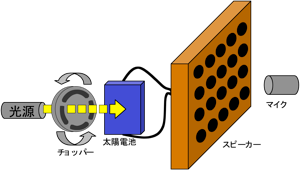Laser Speaker - Driving a speaker by laser


A typical acoustic sound energy of a person speaking in normal volume is about a few mW. On the other hand, lasers can easily output power of few 100 mW. Therefore, even if the conversion efficiency is of few percent, it would be possible to actuate speakers by directly using the light energy from lasers. This will make possible a sound system that is wireless and can be controlled remotely without the need of a power supply.
Concept of the laser speaker


A powerful laser beam can drive a loudspeaker at a distant place when power is cut down.
Applications
By using this system, several applications can be thought of. One is the guidance system for the visually impaired. An LED light source emits the sound signal that can be heard using an ear phone connected to the solar panel. The other is a public-address system that works even if the power is out.
Advantages of the laser speaker in comparison with the conventional method.
One of the advantages of this system is that the receptor part of the system has a simple structure and can be easily mass produced with low cost. Another is that the system uses light; therefore, it will not interfere with other electronic devices or people. Also, since light can be controlled with ease, it is possible to send different information at places that are side by side. This is not possible with the system available now, which uses radio waves to transmit information. Other advantages include:
No battery is required. No need for maintenance.
Simple and can be inexpensively mass-produced.
Environmentally friendly. No hazardous material.
Emits very low noise.
Not affected by magnetic field.
Precisely controlled area of reception.
Preliminary experiment.
In order to prove that the laser can actually drive a loudspeaker, a preliminary experiment was conducted using a pulsed laser. Click here.
R. Hamamura, T. Yamamoto, and H. Okamura
Impedance matching
In this report, the results of impedance matching will be discussed. The experiment consists of finding the impedance of the solar panel, and matching that impedance with that of the speaker. In the first part, the impedance of the solar panel at its maximum power output is measured. In the second part, a speaker matching the impedance that has been found is prepared and its output is measured. The impedance of the solar panel has been found to be 0.4 ohm. Therefore, a speaker having an impedance of the same value has been made by connecting 20 speakers of 8 ohm in parallel. A halogen lamp has been used as the light source and is cut off by a light chopper in a cycle to simulate light carrying sound information of a certain frequency. The output of speakers of impedance 8 ohm and 0.4 ohm was measured.

Schematic for the measurement of the impedance of a solar cell.


Results
As a result, a conversion efficiency of 0.64 % was gained before impedance matching, using the 8 ohm speaker, and 3.0 % was gained after the impedance matching, using the 0.4 ohm speaker. The maximum sound output gained was 771.3 µW.
Conclusion
The result shows enough output for the possibility of practical use of this system. As the next step in research, a light source having the wave length for optimum energy absorption will be used in efforts to increase the energy efficiency.
Schematic for the measurement of the impedance of a solar cell.

Strategies - three factors for improving the efficiency.
To increase the conversion efficiency, three methods are to be considered. One is the adjustment of the generated electric current and electric potential of the solar panel to obtain its maximum power output. Another is the setting of the wave length of the light source for optimum energy absorption of the solar cell. Lastly, the impedance matching of the solar panel and the speaker is to be done.
Maximizing the power from the solar panel
The solar panel is a semiconductor device and works best at optimum conditions. In the I-V curve plotted below, the maximum output can be drawn from the solar panel when P = I x V is maximum.
I-V curve for a solar cell.
The guidance system for the visually impaired. (Details)